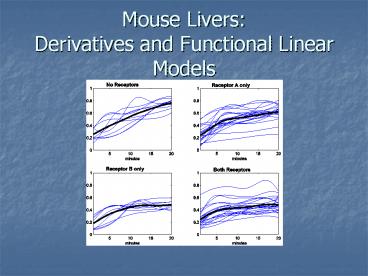Mouse Livers: Derivatives and Functional Linear Models - PowerPoint PPT Presentation
Title:
Mouse Livers: Derivatives and Functional Linear Models
Description:
Mouse Livers: Derivatives and Functional Linear Models What questions can we ask of the data? What does the real, smooth process look like? – PowerPoint PPT presentation
Number of Views:76
Avg rating:3.0/5.0
Title: Mouse Livers: Derivatives and Functional Linear Models
1
Mouse LiversDerivatives and Functional Linear
Models
2
How does cholesterol get metabolized in the liver?
3
What questions can we ask of the data?
- What does the real, smooth process look like?
- Do shapes differ among groups?
- Do rates of change differ among groups?
4
What do the flow curves look like as functional
objects?
- Took the derivative of the smoothed curves.
- Still retain curve-to-curve variability, but now
much smoother.
5
How can I graphically explore the data?
Phase-Plane Plots
- Have
- flow curves x(t).
- rate of change of flow curves Dx(t).
- Plot Dx(t) vs x(t). No longer an explicit
function of time! - Overlay time points on the curve for
interpretation. - Gives information about how function is linked
with its derivative.
6
What do we see in these phase-plane plots?
- Difference in curves between receptors and no
receptors - Cusps or change-points when there are receptors
- Minute 9 for Receptor A Minute 15 for Receptor B
- Minute 9 for Both Receptors Interactive Effect?
7
What is the relationship between the covariates
and response curves?
Functional Linear Models
- Functional response Scalar predictors.
- Regression coefficients are functional.
- Use basis expansion methods.
X(t) ß0(t) ß1(t)A ß2(t)B ß3(t)AB e(t),
8
- Receptors affect steady state.
- B stronger than A.
- Effects strongest after minute 9.
- A and B have inhibitory relationship after minute
9.
9
- Receptors affect steady state.
- B stronger than A.
- Effects strongest after minute 9.
- A and B have inhibitory relationship after minute
9.
10
(No Transcript)
11
- Can also do a functional linear model for
derivative (rate of change) - FDA allows us to work with derivatives which
are closer to the mechanisms of the process
dX/dt ß0(t) ß1(t)A ß2(t)B ß3(t)AB e(t),
12
- A kicks in earlier than does B.
- A kicks in at minute 9, B at minute 15.
- When together, see push only at minute 9 (from
A?)
13
(No Transcript)
14
(No Transcript)
15
What have we learned?
- Creating a functional object
- Smoothing with basis expansions to reduce noise
- Examining derivatives graphically
- Phase-plane plots
- Building functional linear models
- Functional regression coefficients
- Derivatives helpful here, too































